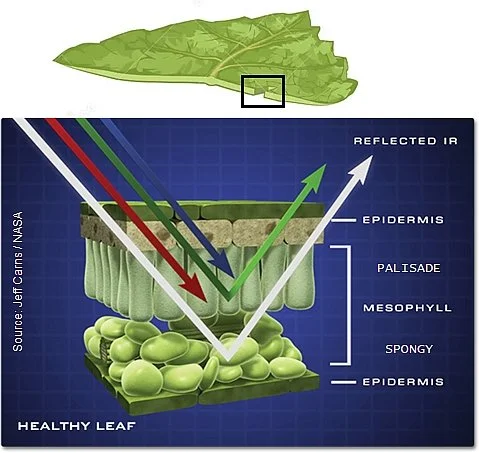My current project involves mapping forests in southern Sweden using the Sentinel satellites and the other day I was looking up satellite-derived spectral indices to implement in my study area. During my literature search, I came across this 2004 paper (screen-grabbed below) in the International Journal of Remote Sensing. Although it is common practice to cite the latest literature, it’s usually a good idea to go through older papers that cover topics relevant to your research because they often contain information that is useful in your work. This paper was a good reminder of the early work that involved the use of satellite-derived vegetation indices for characterizing forest ecosystems. Because the study area of the paper was the Great Plains of the United States and it involved NDVI, it sent me down a rabbit-hole of sorts as I began to look up the history of the index and its various applications over the years.
Most students of remote sensing know that the birth of satellite-derived Normalized Difference Vegetation Index (NDVI) dates back to the 1970s. In 1972, the Earth Resources Technology Satellite-1, ERTS-1 (later renamed Landsat 1) was the first (civilian) Earth observation satellite designed to monitor and study the planet's landmasses. It carried a Multi-Spectral Scanner (MSS) that provided data in several spectral bands, which were crucial for developing vegetation indices. In the early 1970s, researchers sought to harness the burgeoning field of satellite remote sensing to address ecological and agricultural challenges. This type of applied research was part of a broader effort to utilize satellite data for monitoring and analyzing Earth's vegetation.
NDVI was developed by John W. Rouse an colleagues in 1973 at Texas A&M University where the Great Plains Corridor Project was conducted. Their work built upon an earlier study by Frank J. Kriegler and colleagues in 1969 at the University of Michigan, who proposed the use of mathematical transformations to enhance the interpretability of multispectral data. One of these transformations was the normalized difference spectral index, which aimed to improve the recognition and discrimination of different surface materials, including vegetation.While Kriegler’s normalized difference spectral index was an important innovation, it was not specifically derived from satellite data. The concept was later adapted and applied to satellite remote sensing by Rouse et al. in 1973 and 1974, leading to the development of the NDVI using data from ERTS-1. This adaptation marked a significant milestone in the use of satellite data for environmental monitoring and the widespread adoption of NDVI in various scientific and practical applications.
The seminal paper by Rouse et al. (1973) titled “Monitoring the Vernal Advancement and Retrogradation (Green Wave Effect) of Natural Vegetation” introduced NDVI as a means to measure and monitor plant growth, vegetation cover, and biomass production from satellite data. This index was designed to quantify vegetation by measuring the difference between near-infrared (which vegetation strongly reflects) and red light (which vegetation absorbs) and normalizing it to account for varying lighting conditions. The pioneering work on NDVI was later presented by Rouse and his colleagues at the Third Earth Resources Technology Satellite-1 Symposium under title “Monitoring Vegetation Systems in the Great Plains with ERTS”. In their paper, the authors described their research on using data from ERTS-1 to monitor the health of vegetation, which included the development of the NDVI. The symposium was organized by NASA and held in 1974 to discuss the results and applications of data from the ERTS-1 satellite, which was the first satellite in the Landsat program. It aimed to bring together scientists, researchers, and professionals from various disciplines to discuss the initial findings and potential applications of the data collected by the satellite. The symposium provided a platform for sharing research results and exploring how satellite remote sensing could be used for earth resource management. All the original documentation from the 1970s can be downloaded from the NASA Technical Reports Server.
This early application of NDVI set the stage for its widespread use in satellite remote sensing and environmental monitoring, making it one of the most commonly used vegetation indices in Earth observation today. Compton Tucker's work in 1979 further refined and popularized the use of NDVI and other vegetation indices, demonstrating their utility in satellite remote sensing for global vegetation monitoring. Tucker's contributions helped solidify NDVI as a critical tool in the field and expanded its application in various scientific and practical domains.
The invention of NDVI provided a groundbreaking tool that could translate raw spectral data from satellites into actionable information about the Earth's vegetation. This innovation laid the groundwork for the extensive use of NDVI in various scientific, environmental, and agricultural disciplines. So, what does NDVI tell us about the environment?
“Seeing” ecosystem health from space
The key science behind the NDVI lies in its ability to leverage the distinctive way plants interact with light to assess vegetation health and density. Plants have a unique spectral signature: they absorb most visible light, especially red light, for photosynthesis, while reflecting a bit of the green light, which is why they look green to us. Plants reflect a significant portion of near-infrared (NIR) light due to the internal structure of their leaves. Humans can’t see this strong NIR reflectance, but we have designed sensors that can. Anyway, this difference in light absorption and reflection between the red and the NIR forms the basis of NDVI.
NDVI is calculated using a simple formula: (NIR - Red) / (NIR + Red), see image below. This equation generates values between -1 and +1, where higher values (blue colors in the image) indicate healthier and denser vegetation, and lower values (red colors in the image) suggest sparse vegetation or non-vegetated surfaces like water or bare soil. By normalizing the difference between the NIR and red bands, NDVI minimizes the effects of varying lighting conditions and sensor differences, providing a consistent measure of vegetation cover.
What NDVI really tells us is the relative biomass and health of vegetation in a given area. High NDVI values correspond to lush, green vegetation with high chlorophyll content, indicative of healthy, photosynthetically active plants. Low NDVI values might indicate stressed or sparse vegetation, or areas without significant plant life. This information is crucial for monitoring agricultural lands, forests, and natural ecosystems.
NDVI enables the observation of seasonal growth patterns, detection of plant stress due to drought or disease, and assessment of the impact of natural disasters like fires or floods on vegetation. It also helps in tracking deforestation and land degradation over time. By providing a quantitative, spatially extensive, and temporally consistent measure of vegetation, NDVI has become a fundamental tool in environmental monitoring and management.
Ultimately, NDVI transforms raw satellite data into meaningful insights about the Earth's vegetative landscapes, guiding decisions in agriculture, forestry, conservation, and urban planning. It allows scientists and policymakers to understand ecological dynamics, predict crop yields, manage natural resources sustainably, and address environmental challenges more effectively.
A paradigm shift in Earth observation
The invention of the NDVI marked a paradigm shift in remote sensing of the environment because it introduced a revolutionary way to quantify and monitor vegetation health and distribution on a global scale. Before NDVI, analyzing vegetation cover and condition required labor-intensive ground surveys, which were time-consuming, costly, and limited in scope. The advent of NDVI changed all that by enabling the use of satellite data to provide consistent, reliable, and expansive insights into the Earth's vegetative landscapes.
NDVI harnessed the unique spectral properties of vegetation, specifically how plants absorb red light for photosynthesis and reflect near-infrared light due to their cellular structure. This insight allowed scientists to create a simple yet powerful formula that normalized the difference between these two wavelengths. By doing so, NDVI could effectively distinguish between healthy, vibrant vegetation and stressed or sparse plant life, as well as non-vegetated surfaces like water and bare soil. This index could be calculated easily from satellite images, making it a practical tool for large-scale environmental monitoring.
It is not an understatement to say that the impact of NDVI was profound. In a way it was the first wave* of democratized access to vegetation data by allowing researchers, policymakers, and farmers to monitor plant health over vast areas with unprecedented accuracy and frequency. For the first time, it became possible to observe seasonal and annual changes in vegetation, track the effects of climate change, and assess the impact of natural disasters like droughts and wildfires. In agriculture, NDVI enabled precision farming, where crop health could be monitored in real-time, optimizing the use of resources and improving yields.
* The “democratization” I mean in the previous paragraph is the independence from costly field campaigns. A second wave would occur in 2008 when the entire Landsat data archive and all (current and future) Landsat missions were made available for free to anyone, anywhere.
Moreover, NDVI's ability to provide a consistent, quantitative measure of vegetation across different regions and over time made it an invaluable tool for environmental management and research. It facilitated long-term studies of ecological trends and contributed to our understanding of global biogeochemical cycles. NDVI also supported conservation efforts by identifying areas of deforestation and habitat degradation, guiding interventions to preserve biodiversity.
In essence, NDVI transformed remote sensing from a niche scientific endeavor into a cornerstone of environmental monitoring and management. It bridged the gap between complex satellite data and practical, actionable information, empowering a wide range of applications from scientific research to agricultural planning and environmental conservation. This innovation not only enhanced our ability to understand and protect our planet but also showcases the power of remote sensing technology in addressing global environmental challenges.
Disclaimer: An LLM was used in parts of this blog post to enhance the clarity of the text.



